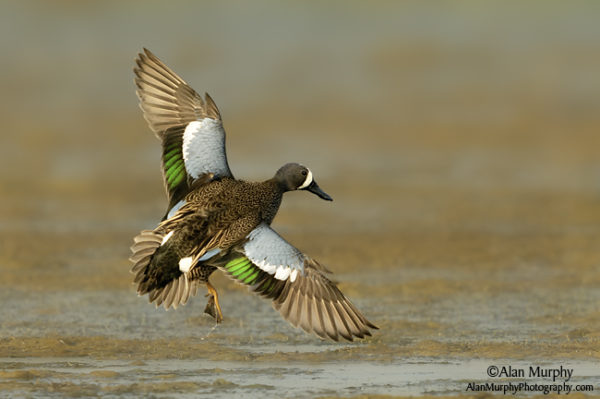
You may think you’re good shot but the small, fast-flying teal will challenge even the most talented wingshooters.
North America has three teal species, blue-winged teal, cinnamon teal, and green-winged teal. They are the smallest of the puddle ducks, with most teal topping out at well under a pound.
They can also be one of the toughest ducks to hit with a shotgun. Many hunters try to explain away their inability to hit teal by citing the birds’ fantastic flying speeds. While teal are actually incapable of approaching the top flight speeds achieved by many larger ducks, they do seem to do everything at an accelerated pace.
Mallards might approach a decoy spread by slowly dropping from the sky like an Airbus, but teal will usually come in like F-16s. They materialize out of nowhere, buzzing low and fast across the water in a wild zigzagging pattern, and then vanish from sight without ever offering a plausible shooting opportunity.
This is especially frustrating because a missed teal is a missed meal and a damn fine meal at that. These small, agile birds are among the finest tasting ducks.
Scientific Names
Green-winged teal (Anas crecca)
Blue-winged teal (Anas discors)
Cinnamon teal (Anas cyanaptera)
Bar Room Banter
Hunters sometimes refer to teal, particularly blue-winged teal and cinnamon teal, as “summer ducks.” The birds are early migrators, and leave their summer nesting grounds well ahead of other duck species and, sometimes, well ahead of the general waterfowl hunting season. Some states accommodate teal hunters by offering an early teal-only duck season.
Green-Winged Teal, A.K.A. Greenwings
Physical Description and Range
Green-winged teal are the smallest puddle duck, weighing only ¾ pound and measuring just 13” to 15”. Drakes have a chestnut-colored head with a dark green ear patch. Sides are barred gray and white; wings are light brown. Hens are mottled brown and generally similar in appearance to the hens of both blue-winged and cinnamon teal. However, hens can be readily identified by their emerald-colored speculum feathers.
Green wing teal breed throughout Alaska, Canada, and the prairie pothole region of the Great Plains and Upper Midwest. The species has widespread wintering grounds, ranging across the southern tier of the U.S. and throughout Mexico and much of Central America. They are particularly abundant in Louisiana and Texas.
Blue-Winged Teal, A.K.A. Bluewings
Physical Description and Range
Blue-winged teal are slightly larger than green-winged teal, weighing up to a pound. Drakes have a slate blue to purple head with a distinctive white facial crescent that runs from the jawline upward past the eye. The bill is long and black, and the body has an overall polka-dotted appearance of black on brown. Speculum feathers are blue.
While hens are mottled brown and very similar in appearance to the hens of green wing teal, their blue speculum feathers can distinguish them. Blue winged teal nest throughout Alaska, across much of Canada, and in most of the United States excluding the Pacific Coast and extreme south. They winter in the southern U.S., Mexico, Central America and South America.
Cinnamon Teal, A.K.A. Red teal
Physical Description and Range
Cinnamon teal weigh up to a pound. Drakes have a cinnamon colored head, neck, breast, and belly. Feet are orange. The bill is wider and more shovel-shaped than other teal. Cinnamon teal hens are virtually indistinguishable from the hens of blue-winged teal; they are mottled brown, with blue shoulder patches and dark green or emerald speculum feathers.
Cinnamon teal nest in the western U.S., particularly along the Pacific Coast and the Great Salt Lake. They winter in the southern portions of California, Arizona and New Mexico, as well as Mexico, Central America, and South America.
Habitat
There is some variation between the three teal species, but the birds are generally found in shallow, heavily vegetated wetlands where food is easily accessible near or above the water’s surface.
Diet
Teal are particularly fond of aquatic plants, including algae, duckweeds, and pondweeds. They will also eat the seeds of various grasses and sedges, as well as a wide variety of aquatic invertebrates.
Life and Death
Like all puddle ducks, teal are hunted by a wide variety of terrestrial, avian, and aquatic predators. Blue-winged teal have the highest mortality rates of any puddle ducks, perhaps due to long migrations.
Breeding and Reproduction
Teal hens typically nest in heavily vegetated, waterside areas, including small islands. Hens lay around 8-10 eggs.
Telltale Sign
Like most duck species, teal leave very little evidence of themselves. Look for feathers and the distinct webbed-foot pattern from their movements around the muddy edges of bodies of water.
Edibility
Teal flesh is generally milder and tenderer than many other duck species. An excellent way to introduce the uninitiated to the joys of eating waterfowl.
For anyone who hasn’t hunted teal it is a trip worth taking. These ducks are fast paced and fun to hunt. With a limit full of teal a hunter will be eating well.





Conversation